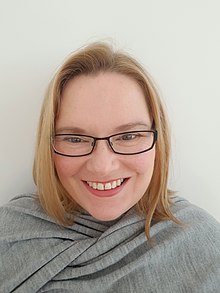Siobhan Leachman
Siobhan Leachman is a New Zealand citizen scientist, open knowledge advocate, and Wikipedian whose work focusses on natural history.[1][2]
Siobhan Leachman | |
|---|---|
 | |
| Nationality | New Zealander |
| Parent(s) |
|
| Awards | Companion of Auckland War Memorial Museum |
Leachman is a lawyer by background and a self-described "stay-at-home mother of two".[2][3] Bored after her children began attending kindergarten,[2] she began her volunteer work at the instigation of her sister Victoria Leachman (rights manager at Te Papa) with the Smithsonian Transcription Center, transcribing diaries and field journals such as those of Vernon and Florence Bailey and categorising bumblebee collections of Arthur Wilson Stelfox.[4][5][6] She moved on to volunteer projects with the Biodiversity Heritage Library,[7] Zooniverse,[8] the Australian Museum, and the New Zealand Virtual Herbarium.[6]
In 2014 at the encouragement of the Smithsonian Transcription Center she began working on Wikipedia; her first article, on botanist and collector Charlotte Cortlandt Ellis, was quickly flagged for deletion.[2][9] She was spending at least two hours a day on Wikipedia, Wikimedia Commons,[10] Wikidata,[11] and iNaturalist,[12] and organised several volunteer events with Wikipedian Mike Dickison.[6] Her Wikipedia work focussed on women in science, neglected scientific collectors, and the endemic moths of New Zealand.[2] Inspired by Ahi Pepe Mothnet, her project to create articles on all 1,800 New Zealand endemic moth species draws on openly-licensed images from iNaturalist, the Auckland Museum, and the New Zealand Arthropod Collection.[1][3] She has been an advocate of open licenses for digital collections of museums and cultural institutions. She has also worked on creating Wikidata entries and Wikipedia articles for female scientific illustrators in the collection of the Biodiversity Heritage Library.[1][13]
.jpg)
Leachman has presented at VALA,[14] New Zealand's National Digital Forum,[15] and WikiDataCon.[16] The Smithsonian invited her to be on the "Build the Crowdsourcing Community of Your Dreams" panel at SXSW in 2016.[17] In 2018 she was awarded a travel scholarship to present at the WikiCite conference in Berkeley, where she spoke about the difficulties of finding metadata on historical biodiversity literature.[18][19] In 2019 at Biodiversity Next in Leiden she spoke about using Bloodhound Tracker (now Bionomia) to link museum specimen data to collectors.[20]
In 2019 Auckland Museum made Leachman a Companion of Auckland War Memorial Museum in recognition of her work with their openly-licensed digital collection images.[18]
Selected works
- Waagmeester, Andra; Mietchen, Daniel; Leachman, Siobhan; Groom, Quentin (2019). "Using Crowd-curation to Improve Taxon Annotations on the Wikimedia Infrastructure". Biodiversity Information Science and Standards. 3: e35216. doi:10.3897/biss.3.35216.
- Leachman, Siobhan (18 June 2019). "Wikimedia Projects and Citizen Science". Biodiversity Information Science and Standards. 3: e34722. doi:10.3897/biss.3.34722.
- Leachman, Siobhan (17 May 2018). "How A Citizen Scientist Can Reuse & Link Biodiversity Heritage Library Data". Biodiversity Information Science and Standards. 2: e25298. doi:10.3897/biss.2.25298.
- Ferriter, Meghan; Rosenfeld, Christine; Boomer, Dana; Burgess, Carla; Leachman, Siobhan; Leachman, Victoria; Moses, Heidi; Pickering, Felicia; Shuler, Megan E. (2016). "Crowdsourcing as Practice and Method in the Smithsonian Transcription Center". Collections. 12 (2): 207–225. doi:10.1177/155019061601200213.
References
- D’Alterio, Emily (18 March 2019). "Women in culture and tech: Siobhan Leachman, Citizen scientist and wikimedian". Europeana Pro. Retrieved 25 June 2020.
- Macdonald, Nikki (9 November 2018). "How it is decided who is Wikipedia-worthy". Stuff. Retrieved 25 June 2020.
- Mulligan, Jesse (22 November 2018). "Sharing Kiwi biodiversity online". RNZ. Retrieved 27 June 2020.
- "Online Amateurs Feed Their Science and History Addictions". NBC News. 17 October 2014. Retrieved 25 June 2020.
- Crow, Kelly (11 September 2014). "The Smithsonian Works to Digitize Millions of Documents". Wall Street Journal. Retrieved 25 June 2020.
- Arnold, Naomi (July–August 2016). "Natural History 2.0". New Zealand Geographic. 140.
- "Siobhan Leachman". Biodiversity Heritage Library blog.
- "Siobhan Leachman". Zooniverse. Retrieved 28 June 2020.
- "Ambrosia10 - Wikipedia (en.wikipedia.org) - Edit Counter - XTools".
- "Ambrosia10 - Wikimedia Commons (commons.wikimedia.org) - Edit Counter - XTools".
- "Siobhan Leachman". www.wikidata.org.
- "Siobhan Leachman's Profile". iNaturalist NZ. Retrieved 28 June 2020.
- Leachman, Siobhan (23 May 2017). "The Serendipitous Discovery of Susan Fereday: A Story about the Impact of Citizen Science". Biodiversity Heritage Library. Retrieved 28 June 2020.
- "VALA2020 Plenary 4 Leachman". 10 December 2019.
- Butler, Nick (21 January 2020). "Copyright for digital GLAMs: Lessons from NDF2019". Boost. Retrieved 26 June 2020.
- "WikidataCon 2019 Program". Wikidata.
- "Build the Crowdsourcing Community of Your Dreams | SXSW 2016 Event Schedule". SXSW Schedule 2016. Retrieved 26 June 2020.
- Auckland Museum (1 March 2019). "Museum Medals Honour Outstanding Individuals". Scoop News.
- Leachman, Siobhan; Shaw, Diane; Mika, Katherine (31 January 2019). "BHL and WikiCite 2018". Biodiversity Heritage Library. Retrieved 28 June 2020.
- Page, Roderic (5 November 2019). "Thoughts on Biodiversity Next". iPhylo. ISSN 2051-8188.
External links
| Wikimedia Commons has media related to Siobhan Leachman. |
- Siobhan Leachman on Twitter
- Siobhan Leachman on LinkedIn
- Siobhan Leachman on Tumblr
- "Crowdsourcing & how GLAMs encourage me to participate" (presentation by Leachman at National Digital Forum 2016)
- "Giz it: A journey in reuse" (presentation on behalf of Leachman at National Digital Forum 2019)
- "Sharing Kiwi biodiversity online" (interview with Leachman on RNZ Afternoons)